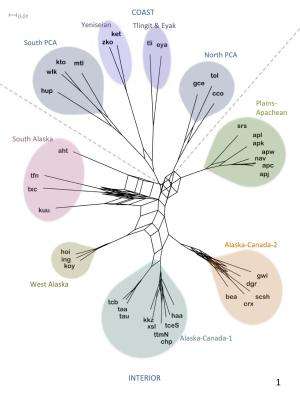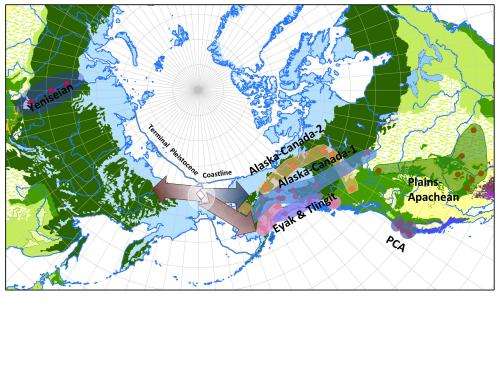Language 'evolution' may shed light on human migration out-of-Beringia

Evolutionary analysis applied to the relationship between North American and Central Siberian languages may indicate that people moved out from the Bering Land Bridge, with some migrating back to central Asia and others into North America, according to a paper published in the open-access journal PLOS ONE on March 12, 2014 by Mark Sicoli, from Georgetown University and Gary Holton from University of Alaska Fairbanks.
Languages evolve slowly overtime and may even follow human migratory patterns. A proposed language family known as the Dené–Yeniseian suggests that there are common language elements between the North American Na-Dene languages and the Yeniseian languages of Central Siberia. To investigate this further, scientists employed a technique originally developed to investigate evolutionary relationships between biological species called phylogenetic analysis, where a tree is constructed to represent relationships of common ancestry based on shared traits. Scientists used linguistic phylogeny to work out how approximately 40 languages from the area diffused across North America and Asia. The authors first coded a linguistic dataset from the languages, modeled the relationship between the data, and then modeled it against migration patterns from Asia to North America, or out-of-Beringia.
Results show an early dispersal of Na-Dene along the North American coast with a Yeniseian back migration through Siberia and a later dispersal of North American interior Na-Dene languages. Sicoli explained, "we used computational phylogenetic methods to impose constraints on possible family tree relationships modeling both an Out-of-Beringia hypothesis and an Out-of-Asia hypothesis and tested these against the linguistic data. We found substantial support for the out-of-Beringia dispersal adding to a growing body of evidence for an ancestral population in Beringia before the land bridge was inundated by rising sea levels at the end of the last ice age." Although the authors cannot conclusively determine the migration pattern just from these results, and state that this study does not necessarily contradict the popular tale of hunters entering the New World through Beringia, it at the very least indicates that migration may not have been a one-way trip. This work also helps demonstrate the usefulness of evolutionary modeling with linguistic trees for investigating these types of questions.

These finding suggest that phylogenetics may be used to explore the implications of deep linguistic relationships.
More information: Sicoli MA, Holton G (2014) Linguistic Phylogenies Support Back-Migration from Beringia to Asia. PLoS ONE 9(3): e91722. DOI: 10.1371/journal.pone.0091722
Journal information: PLoS ONE
Provided by Public Library of Science

















